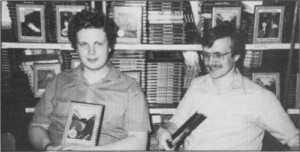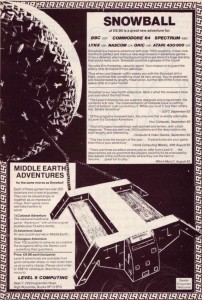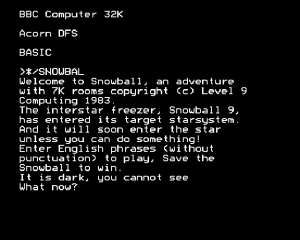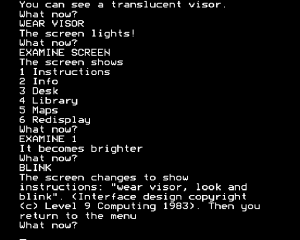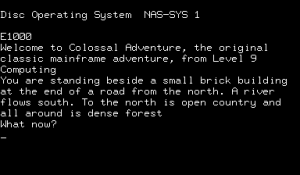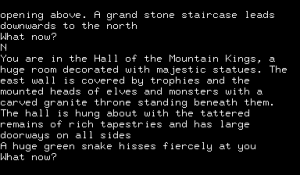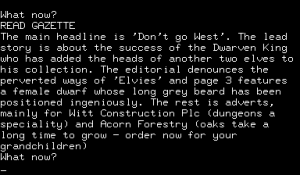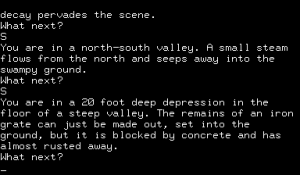The first weeks of 1983 brought the last gasp of Level 9 as a publisher of generalized software in the form of an implementation of the Forth programming language (a Great White Hope for programming in the early 1980s that never quite caught on as anticipated) for the BBC Micro. The disappointing sales of that product, contrasted with the ever-quickening sales of their three adventures, guaranteed that Level 9 would live or die by their adventure games from here on. Thus, over the course of 1983 the Austin family transformed Level 9 from a hobby into the company that has gone down in history as the “British Infocom,” the most long-lived, dedicated, and arguably most important British publisher of the text adventure’s relatively brief lifespan as a viable commercial proposition.
Unable to keep up with rising demand by duplicating each cassette by hand, they signed contracts to begin churning out their games in bulk, the way the pros did it. At the same time they replaced their Ziploc baggies and mimeographed cassette inserts with real boxes which included real instruction manuals. With their beloved Nascoms fading in importance in a computing milieu now dominated by the likes of Sinclair and Acorn, the brothers began doing their development work on the BBC Micro. However, the two younger Austin brothers, Mike and Nick, continued to develop A-Code interpreters for many other platforms, bringing Level 9’s games to an ever-widening slice of the British microcomputer market. By fall their games were available for the Nascom, the BBC Micro, the Sinclair Spectrum, the Atari 8-bit line, the Commodore 64, the Camputers Lynx, and the Oric-1, with yet more platforms soon to follow. Meanwhile the lone Austin sister, Margaret, took over marketing. With sales now substantial enough to pay for them, full-page spreads began appearing around this time in the major magazines in lieu of the little classified ads with which Level 9 had made do in earlier years.
At the center of this web of activity was the eldest brother, Pete, who quit his day job in June of 1983 to become Level 9’s first full-time employee, soon to be joined by the youngest Austin, Mike, who took a year off from his education before starting university to help with the company. It was Pete who actually designed the games, as well as being the de facto leader and day-to-day manager of the family business. What with being so busy with the logistics of getting Level 9 up and running in earnest, Pete found time to design just one game for Level 9 in 1983, which in turn became the company’s only new adventure of the year. Still, that game, an exercise in hard science fiction which he called Snowball, was an important one, first fruit of a deepening determination to create adventures that were coherent fictional experiences. That determination would set Level 9 apart from most of their peers in the time to come, and would provide, even more so than their reliance on a cross-platform virtual machine or their impressive technical standards, a good reason to call them the British Infocom.
A comparison of Snowball to Peter Killworth’s science-fiction game of the same year, Countdown to Doom, might help to illustrate how Level 9 was now diverging from the Cambridge/Acornsoft nexus. The planet of Doomawangara makes absolutely no sense as a piece of world-building. Glaciers sit next to deserts next to jungles; it’s enough to make even a Star Trek writer blush. The game’s fictional context, like the world, like the conceit of needing to finish your work and get away before your ship disappears in 215 turns, exists merely as a frame for the devious, clever, surreal, inspiring, occasionally infuriating puzzles (including, of course, the meta-puzzle of solving all of those other puzzles within the time limit). There’s nothing wrong with such an approach; Countdown to Doom can provide quite a compelling experience for hardcore puzzle fans. Still, Pete Austin was aiming at something quite different in Snowball, something more demanding and perhaps ultimately more rewarding.
Level 9’s first trilogy of games had made occasional nods in the direction Snowball would now travel with determination. All three otherwise traditional fantasy puzzlefests are occasionally interrupted by odd, lumpy bits of exposition and plot that seem dropped in from some other creative endeavor entirely, as in the climax of Colossal Adventure when Crowther and Woods’s Adventure suddenly turns into a desperate mission to rescue 300 elves being held prisoner by a nation of evil dwarfs that apparently lives below Kentucky. But with Snowball the world-building really comes to the fore. A fan of the intellectual rigorousness of hard science fiction like that of Larry Niven (he listed The Mote in God’s Eye as a particular inspiration), Pete Austin strove with Snowball to craft a fictional environment that actually makes sense, that could make a coherent setting for a novel. As described in a detailed background section in the manual (shades of Infocom yet again), the game takes place aboard the eponymous Snowball 9, a massive colony ship carrying 1.8 million people, all in cryogenic sleep, on a journey of over a hundred years to the planet of Eden. The ship gets its name from the shell of ice which is constructed around it at the beginning of the voyage:
The chain of accelerators beyond Pluto burst erratically into life throughout the following three years, firing ten-tonne blocks of ammonia ice at precise speeds after the receding craft. Once reeled in by the Snowball’s skyhooks, the ice was built into a huge hollow shell around the linked passenger disks. When complete, this shielded the disks during the voyage, until the ice was finally needed as fuel for the ravening fusion drives.
As the above excerpt may illustrate, Snowball offers Big Ideas, and can inspire in the player the awe-inspiring, almost religious epiphany of coming face to face with wonders on a scale bigger than we as individual 21st-century humans can entirely fathom. And, as the above excerpt should also illustrate, the environment of Snowball is worked out with impressive care. In addition to its descriptions of the Snowball itself, the manual also includes the circumstances of her birth in the form of a history of humanity until the launch of Snowball and her 49 sister colony ships in the 2190s. None of this history bears all that directly on the game itself, but it does do much to make Snowball a holistic fictional experience, in a way that really only Infocom was also attempting to do at this date.
Surprisingly, all of this emphasis on coherence and (science-fictional) realism leads quite naturally to the most remembered, most mocked, and perhaps most misunderstood attribute of the game today: its geography of “over 7000 locations.”
When it comes up today, this data point is always followed by the same punch line: the fact that over 6800 of these rooms are essentially identical. Snowball is used in this context as the ultimate illustration of the absurdities of old-school adventures, with their mazes and sprawling geographies full of corridors and empty rooms. Still, it’s not really a fair portrayal of Snowball. Let’s remember that Pete Austin was trying to present a realistic depiction of this massive colony ship. Let’s further remember that such a ship will inevitably consist of endless identical rooms and corridors full of the 1.8 million sleeping colonists and the apparatus to maintain them. Snowball doesn’t indulge in mazes for the sake of them, and doesn’t ever demand that we map or visit any but the barest fraction of these rooms. Instead, a central puzzle is that of learning to use the ship’s manifest to identify and find the couple of rooms amongst this menagerie that you do need to visit. In this sense Snowball is anti-old-school: someone who tries to dutifully visit and map every single room in classic adventurer fashion, ignoring her role as a fictional actor in this world, is simply playing with the wrong mindset entirely. (That said, less defensible was Level 9’s decision to use the “over 7000 rooms” tagline as their centerpiece for marketing this “massive adventure.” For that they were roundly mocked even in the computer press of the time, and with good reason.)
In trying to make the leap from text adventure to interactive fiction, Pete Austin faced many of the same questions with which the Infocom authors were wrestling. In particular: to what extent could or should the author define the protagonist? Would players insist on playing “themselves” in adventure games, or would they be willing to play a role assigned to them, as it were, by the needs of the fiction? Pete created a detailed profile of the protagonist, Kim Kimberly, and included it in the manual. Kim’s gender, however, he left unspecified. When asked about his reasons for doing so, he often noted that as many as one-third of the people who played Level 9 games regularly were female. In deference to them, he made the decision to try to make all of his games “non-sexist.” It’s of course problematic in the extreme to assert that a game which merely features a male — or female, for that matter — protagonist is automatically sexist. Nor is it entirely clear that players, male or female, otherwise willing to accept inhabiting a role very different from themselves would determine that playing someone of the opposite sex would be the deal-breaker. In an interview for Micro-Adventurer, Pete went on to make the more straighforwardly sexist — or at least condescending — assertion that “adventure games offer many women, trapped at home by children, a more intellectual alternative to Mills and Boon.” Ah, well, at least the fellow was trying, which is more than could be said for most of his peers.
Progressive as it is in so many ways, Snowball still has its full share of problems and questionable elements. Like the three fantasy games that preceded it, it’s just much too hard, and too often for the wrong reasons. The most infamously awful puzzle involves a computer screen which is operated by looking at desired entries in a menu and then BLINKing, a completely unclued combination of the design sin of read-the-author’s-mind with just a dash of guess-the-verb. Just to really salt the wound, the first entry you read after — let’s be honest — looking the answer up in a walkthrough is… instructions on how to operate the computer. Grr…
The parser, while it does understand phrases of more than two words to an extent, is very unrefined compared to that of Infocom. You see, the parser here lies — or, if you like, cheats. When it encounters a phrase it doesn’t entirely understand, it attempts to guess the meaning from those words it does. This is a fraught approach, with huge potential to result in misunderstandings. You’re thus likely to see a lot of weird non-sequitur responses in your time with Snowball.
And then the actual plot that develops in the game itself, involving a hijacker who is attempting to crash the Snowball into the Eden system’s star for reasons that are never really explained just as it will soon be time to begin reviving the colonists and sending them down to their new lives at last, is oddly sparse in comparison to the meticulous back story.
All of these weaknesses can largely be attributed to the draconian technical constraints of the 32 K, cassette-based machines that represented the lowest common denominator for which Level 9 had to develop. I mention them here only so you won’t think that Snowball is possessed of quite the same sophistication and polish of a contemporaneous Infocom game. By comparison Infocom, with the luxuries of an extra 16 K of memory and floppy-disk-enabled virtual memory, had it easy. Still, Snowball packs a staggering amount of content into 32 K, and is in that light if anything even more technically impressive than Infocom’s games.
Indeed, when compared with the most obviously similar game in the Infocom canon, Starcross, Snowball acquits itself pretty darn well. While Starcross owes a hell of a debt to Arthur C. Clarke’s Rendezvous with Rama, Snowball is braver, more audacious in proposing a more original science-fictional concept and working it out so carefully. If its plot is ultimately a bit slight, well, plenty of science-fiction novels are also more interesting for their worldbuilding than their plot. I would even say that Snowball gets the sense of wonder of the best science fiction across better than Starcross. There are a few moments, such as when you exit the ship proper to the interior of the globe of snow and see this huge man-made wonder stretching out around you, that approach the transcendent even given the bare few sentences Pete Austin can spare to describe the scene. Anyone playing along at the time had to recognize the audacity that was lacking in most of Level 9’s peers, and had to be excited to see where it would take them. That’s a journey I’ll be continuing to follow here with relish.
For anyone playing along with these articles, I’ve prepared a zip file which includes Snowball in its BBC Micro disk incarnation as well as the original manual and a hints sheet, which, once again, you’re likely to need. Next time we’ll wrap up 1983 in Britain with the most important adventuring development of the year — which wasn’t even a game per se.
